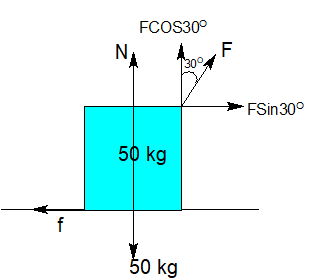
A block of mass 50 Kg can slide on a rough horizontal surface. The coefficient of friction between the block and the surface is 0.6. The least force of pull acting at an angle of ${30^0}$ to the upward drawn vertical which causes the block to just slide is:
A. 29.43 N
B. 219.6 N
C. 21.96 N
D. 294.3 N
Answer
219k+ views
Hint:Here we first need to find the frictional force that will cause the block to slide. For this first we have to find the horizontal and the vertical component of the force given. Also the angle for the force is also given. Then equate the horizontal component of the force with the frictional force in order to get the required answer.
Formula used:
1. Reaction force, $R = mg - F\cos \theta $
2. Frictional force, $f = \mu R$
Where, $\mu $is the coefficient of frictional force.
Complete step by step solution:
The free body diagram can be drawn as

Let the force applied on the body at the given angle be F.
Given angle, $\theta = {30^0}$.
This force will consist of horizontal and vertical components.
Vertical component of force will be $F\cos \theta = F\cos {30^0}$.
Horizontal component of force will be $F\sin \theta = F\sin {30^0}$.
Reactional force will be:
$R = mg - F\cos \theta $
Putting the values from the question, we get:
$R = 50 \times 10 - F\cos {30^0}$
By solving;
$R = 500 - F\dfrac{{\sqrt 3 }}{2}$
Now, frictional force is given as follows:
$f = \mu R$ (equation 1)
Also f will be equal to horizontal component of force:
$f = F\sin {30^0}$ (equation 2)
Equating equation 1 and 2, we get;
$\dfrac{F}{2} = \left[ {(500 - F\left( {\dfrac{{\sqrt 3 }}{2}} \right)} \right]\mu $
By solving;
$F = (1000 - F\sqrt 3 )0.6$
$\therefore F = 294.3\,N$
Hence, the correct answer is option D.
Note: Here the vertical component of force balances the mg force applied on the body in downward vertical direction and the horizontal component balances the frictional force applied on the body. Reactional force will be resultant of all the vertical forces applied on the given body. Then finally multiplying it with the frictional coefficient we will get the final answer.
Formula used:
1. Reaction force, $R = mg - F\cos \theta $
2. Frictional force, $f = \mu R$
Where, $\mu $is the coefficient of frictional force.
Complete step by step solution:
The free body diagram can be drawn as

Let the force applied on the body at the given angle be F.
Given angle, $\theta = {30^0}$.
This force will consist of horizontal and vertical components.
Vertical component of force will be $F\cos \theta = F\cos {30^0}$.
Horizontal component of force will be $F\sin \theta = F\sin {30^0}$.
Reactional force will be:
$R = mg - F\cos \theta $
Putting the values from the question, we get:
$R = 50 \times 10 - F\cos {30^0}$
By solving;
$R = 500 - F\dfrac{{\sqrt 3 }}{2}$
Now, frictional force is given as follows:
$f = \mu R$ (equation 1)
Also f will be equal to horizontal component of force:
$f = F\sin {30^0}$ (equation 2)
Equating equation 1 and 2, we get;
$\dfrac{F}{2} = \left[ {(500 - F\left( {\dfrac{{\sqrt 3 }}{2}} \right)} \right]\mu $
By solving;
$F = (1000 - F\sqrt 3 )0.6$
$\therefore F = 294.3\,N$
Hence, the correct answer is option D.
Note: Here the vertical component of force balances the mg force applied on the body in downward vertical direction and the horizontal component balances the frictional force applied on the body. Reactional force will be resultant of all the vertical forces applied on the given body. Then finally multiplying it with the frictional coefficient we will get the final answer.
Recently Updated Pages
Two discs which are rotating about their respective class 11 physics JEE_Main

A ladder rests against a frictionless vertical wall class 11 physics JEE_Main

Two simple pendulums of lengths 1 m and 16 m respectively class 11 physics JEE_Main

The slopes of isothermal and adiabatic curves are related class 11 physics JEE_Main

A trolly falling freely on an inclined plane as shown class 11 physics JEE_Main

The masses M1 and M2M2 M1 are released from rest Using class 11 physics JEE_Main

Trending doubts
JEE Main 2026: Application Form Open, Exam Dates, Syllabus, Eligibility & Question Papers

Understanding Uniform Acceleration in Physics

Derivation of Equation of Trajectory Explained for Students

Hybridisation in Chemistry – Concept, Types & Applications

Understanding the Angle of Deviation in a Prism

Understanding Collisions: Types and Examples for Students

Other Pages
JEE Advanced Marks vs Ranks 2025: Understanding Category-wise Qualifying Marks and Previous Year Cut-offs

Units And Measurements Class 11 Physics Chapter 1 CBSE Notes - 2025-26

NCERT Solutions For Class 11 Physics Chapter 8 Mechanical Properties Of Solids

Motion in a Straight Line Class 11 Physics Chapter 2 CBSE Notes - 2025-26

NCERT Solutions for Class 11 Physics Chapter 7 Gravitation 2025-26

Understanding Atomic Structure for Beginners




